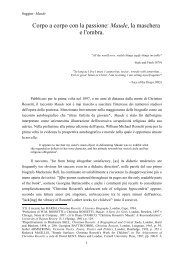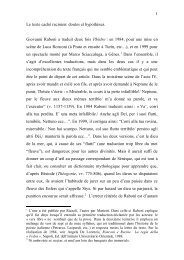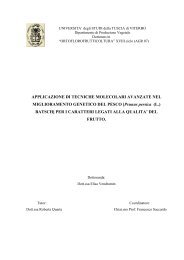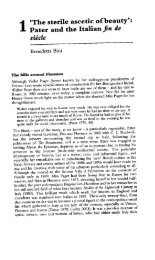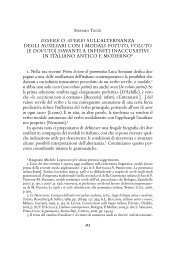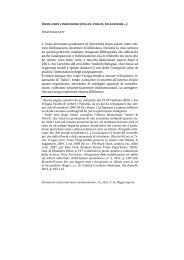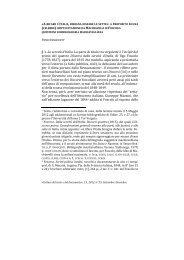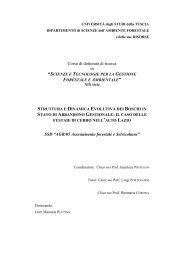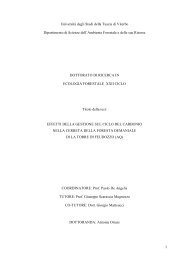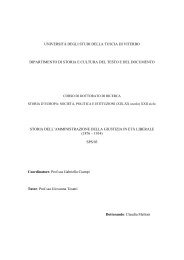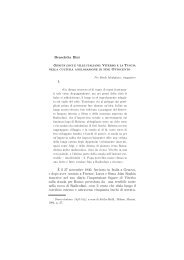drivers of soil respiration of root and microbial ... - Unitus DSpace
drivers of soil respiration of root and microbial ... - Unitus DSpace
drivers of soil respiration of root and microbial ... - Unitus DSpace
Create successful ePaper yourself
Turn your PDF publications into a flip-book with our unique Google optimized e-Paper software.
2.1. Introduction<br />
36<br />
Soil <strong>respiration</strong> (Rs) is an important component <strong>of</strong> the ecosystem C budgets. It is a major<br />
source <strong>of</strong> CO2 released by terrestrial ecosystems <strong>and</strong> after the photosynthesis, CO2 efflux from <strong>soil</strong><br />
remains the second largest C flux accounting for 60-90% <strong>of</strong> total ecosystem <strong>respiration</strong> (Goulden et<br />
al., 1996; Longdoz et al., 2000; Raich <strong>and</strong> Schlesinger, 1992). Rs is known to experience high<br />
spatial <strong>and</strong> temporal variation with different controlling factors involved on different time-scales.<br />
However, up to now not so many studies have deal with the interannual variability <strong>of</strong> <strong>soil</strong><br />
<strong>respiration</strong> <strong>and</strong> only few <strong>of</strong> them were performed in grassl<strong>and</strong> ecosystems (Craine et al., 1999;<br />
Mielnick <strong>and</strong> Dugas 2000; Raich et al., 2002; Zhou et al., 2007; Bahn et al., 2008) despite the fact<br />
that it is one <strong>of</strong> the world’ s most widespread vegetation types which comprises 32% <strong>of</strong> the earth’ s<br />
area <strong>of</strong> natural vegetation (Adams et al., 1990).<br />
Rs integrate the CO2 produced by <strong>soil</strong> microorganisms in the <strong>root</strong>-free <strong>and</strong> <strong>root</strong>-affected <strong>soil</strong><br />
<strong>and</strong> actual <strong>root</strong> <strong>respiration</strong>. Microbial <strong>respiration</strong> in the <strong>root</strong>-affected <strong>soil</strong>, so called rhizo<strong>microbial</strong><br />
<strong>respiration</strong>, is closely coupled to <strong>root</strong>s distribution <strong>and</strong> activity <strong>and</strong> could be hardly separated from<br />
the last one (Kuzyakov, 2006). We will call this type <strong>of</strong> <strong>respiration</strong> as ‘<strong>root</strong>-derived’ (Ra), <strong>and</strong> the<br />
CO2 originated from the <strong>root</strong>-free <strong>soil</strong> as ‘<strong>microbial</strong>-derived’ <strong>respiration</strong> (Rh). According to recent<br />
reviews the relative contribution <strong>of</strong> Ra <strong>and</strong> Rh generally accounts for approximately one half <strong>of</strong> the<br />
total CO2 efflux (Hanson et al., 2000, Subke et al., 2006), but varies significantly among studies<br />
(10-90%) Quantifying the contribution <strong>of</strong> these two major respiratory sources to the total CO2<br />
efflux <strong>and</strong> underst<strong>and</strong>ing the seasonal <strong>and</strong> interannual variability <strong>and</strong> their response to climate<br />
change is very important for succeed modelling <strong>and</strong> prediction <strong>of</strong> the ecosystem C cycling. The<br />
potential change in <strong>soil</strong> CO2 efflux will largely depend on the relative contribution <strong>of</strong> Ra <strong>and</strong> Rh to<br />
the total CO2 efflux.<br />
The dynamic <strong>of</strong> the two components <strong>of</strong> <strong>soil</strong> <strong>respiration</strong> may be controlled by different<br />
abiotic <strong>and</strong> biotic factors, such as temperature, water availability, nutrient supply, plant<br />
phenological development. In addition, the response <strong>of</strong> Ra <strong>and</strong> Rh to the temperature changes is<br />
different, exhibiting various Q10 value (Boone et al., 1998; Rey et al., 2002). Recent studies have<br />
shown that apart <strong>of</strong> well studied effect <strong>of</strong> <strong>soil</strong> temperature <strong>and</strong> <strong>soil</strong> water content, the supply <strong>of</strong><br />
assimilates from photosynthetically active plant organs have a significant effect on the <strong>root</strong>-derived<br />
<strong>respiration</strong> (Moyano et al, 2008; Carbone <strong>and</strong> Trumbore, 2007). Due to the fact that in many<br />
ecosystems the contribution <strong>of</strong> <strong>root</strong> <strong>respiration</strong> is quite high <strong>and</strong> could arrive up 90 % <strong>of</strong> total <strong>soil</strong><br />
<strong>respiration</strong> (Hanson et al., 2000), the last could be also affected at a high level by the canopy<br />
photosynthetic activity. In fact, Bahn et al. (2008), Janssens et al. (2001), Reichstein et al. (2003),<br />
Bremer <strong>and</strong> Ham (2002) have shown that within <strong>and</strong> across various grassl<strong>and</strong> <strong>and</strong> forest




